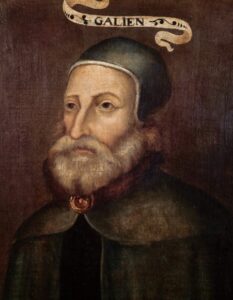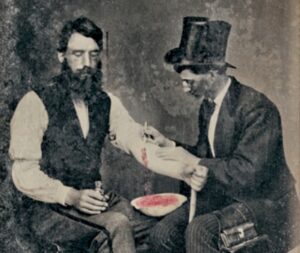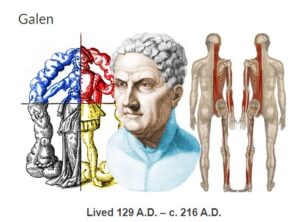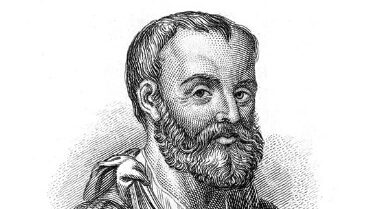If you study the history of medicine, it’s impossible not to be fascinated by the influence and authority of Galen and the length of his dominance in Medicine: more then 1,500 years! This is unprecedented, there is no other scholar that could compare with him. At least, not in Medicine.
To come close to describing Galenism completely or even partially would require an entire book. Or books.
He consolidated the work of previous Greek medical researchers, adding the results of his own research to create an incredibly long-lasting medical doctrine.
So, let start with some background.
Galen (c.130 AD – c.216 AD) was a physician who was born in Pergamum (modern day Turkiye) that was a bustling and vibrant Greek city at the time which was particularly famous for its statue of Asclepius, a god of healing. His parents were Greek. Throughout Galen’s life, he avowed a devotion to Asclepius. The city also had a library that almost rivaled Alexandria’s in its size. Galen’s father, Nicon, was a prosperous architect which allowed him to study free of monetary worries. Like other wealthy people in those times, Galen’s family were slave owners, using slaves to do all the routine work.

He studied in Greece, in Alexandria and other parts of Asia Minor and returned home to become chief physician to the gladiator school in Pergamum, gaining much experience of treating wounds.
In the early 160s AD, Galen moved to Rome to work and, with the exception of a brief return to Pergamum, spent the remainder of his life in the Roman capital. He became physician to the emperor Marcus Aurelius and would later serve in the same role to Aurelius’s successors, Commodus and Septmius Severus.
Galen was the originator of the experimental method in medical investigation, and throughout his life dissected animals in his quest to understand how the body functions. No human dissections were allowed in those times. Some of his anatomical and physiological observations were accurate – for example, he proved that urine was formed in the kidney (as opposed to the bladder which was common belief). His most important discovery was that arteries carry blood although he did not discover circulation.
Galen was very prolific, with hundreds of treatises to his name. He compiled all significant Greek and Roman medical thought to date, and added his own discoveries and theories. His influence reigned supreme over medicine for 15 centuries after his death. It was not until the Renaissance that many of his theories were refuted.
Galen’s 1500 Year Domination of Medicine
Using his own and other people’s discoveries, Galen molded a medical doctrine that dominated medicine in Europe and Arab countries for 1,500 years.
Although practitioners in Arab countries and Persia noticed problems with aspects of Galen’s work, it seems nobody had the authority to completely overturn what had been the final word in medicine for so many centuries. His authority was so overbearing that nobody had the courage to oppose him. Subsequently his works effectively remained beyond criticism until the Renaissance.
In Europe the fall of Rome was followed by the dark ages. Medicine entered its own dark age, and far from making progress, medical practices actually went backward until the Renaissance revived interest in progress again.
Andreas Vesalius and William Harvey in the 1500s and 1600s finally exposed flaws in Galen’s understanding of human anatomy and blood circulation. With his doctrine undermined, other unreliable aspects of his work were then gradually identified.
Nevertheless, bloodletting – one of Galen’s recommended methods – was still being used in 19th century Europe. The principle behind bloodletting is to remove some blood in a controlled way so that the patient does not end up bleeding profusely.

A side and interesting note about this gruesome treatment and its connections to barbers: bloodletting.
Hippocrates practiced medicine according to the theory of the four humors, or “humoral theory.” This theory posited that there were four key humors, or liquids, in the human body and that imbalances in these humors were responsible for many physical and mental illnesses. According to the most influential version of this theory, these humors were: black bile, yellow bile, phlegm, and blood. Bloodletting was used as a means of re-establishing the balance of the four humors and treating a variety of symptoms. According to Galen, a bloodletting incision into the veins behind the ears could treat (among others conditions) vertigo and headaches, and letting blood flow out through an incision in the temporal arteries — the veins found on the temples — could treat eye conditions. It is now believed that many more people died from this “treatment” then actually from the diseases were supposed to treat.
In 1163 a church edict prohibited monks and priests, who often stood in as doctors, from performing bloodletting, stating that the church “abhorred” the procedure. Partly in response to this injunction, barbers began offering a range of services that included bloodletting, cupping, tooth extractions, lancing and even amputations—along with, of course, trims and shaves. The modern striped barber’s pole harkens back to the bloodstained towels that would hang outside the offices of these “barber-surgeons.”

Nowadays – when we take progress for granted – it is amazing to think that medicine made so little progress for about 1500 years. It’s as if we in modern times were using, with few modifications, the technology of 500 A.D.!

Galenism
So influential was Galen that his methods came to be known by the word Galenism. To come close to describing Galenism completely or even partially would require a whole book. Rather than that, here are a few bullet-points about Galenic medicine. Please remember, some aspects of Galenism were not actually discovered by Galen himself – he credited other scientists too.
A Sampling of Galenism’s Successes
- Diagnosis of disease by careful attention to the patient’s pulse.
- Diagnosis of disease by careful attention to the patient’s urine.
- Removal of cataracts from patients’ eyes.
- Diagnosis of physical symptoms caused by psychological disturbance.
- Proof that urine forms in kidneys, not the bladder.
- Discovery that arteries carry liquid blood rather than, as previously thought, gaseous air.
- Identification of 7 of the 12 cranial nerves – such as the optic nerve and acoustic nerve.
- Identification of two types of blood – bright red and dark red.
- Discovery that the heart has four valves and they allow blood to flow in only one direction.
A Sampling of Galenism’s Failures
- Belief that diseases are caused by bad air from rotting animal and plant matter.
- Belief that dark blood in the veins is manufactured in the liver to be consumed by the body as food.
- Belief that brightly colored arterial blood is made by the heart to deliver ‘vital spirits’ to the body.
- Routine use of bloodletting as a therapy.
- Belief that arteries are linked to veins by fine blood vessels through which blood and air pass.
- Belief that microscopic pores in the heart’s septum connect the left and right sides of that organ.
- Use of Hippocrates system of ‘humors.’ Hippocrates thought imbalances in the humors of black bile, blood, phlegm, and yellow bile caused disease. Galen added his own contribution of four temperaments, one for each humor.

- Black bile matched melancholic, which meant depressed and despondent.
- Blood matched sanguine, which meant passionate and optimistic.
- Phlegm matched a phlegmatic, which meant unemotional and apathetic.
- Yellow bile matched choleric, which meant quick tempered and stubborn.
The End
Details of Galen’s death are vague. Modern scholars believe he died in about the year 216 A.D., aged 86 or 87, probably in Rome.

